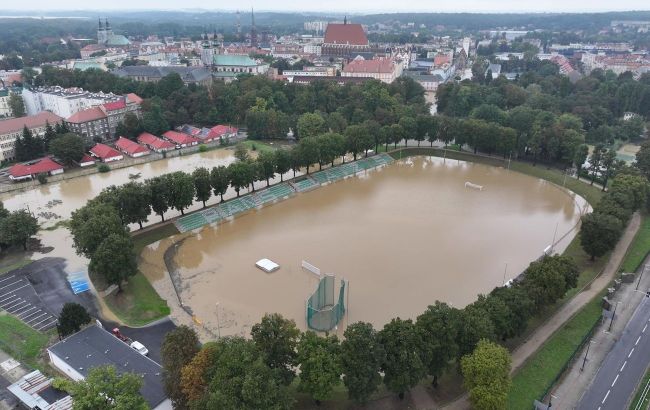Devastating disaster: What is known about flood in Poland and its consequences
 Photo: Flood in the Polish city of Nysa (twitter.com/TygodnikOpolska)
Photo: Flood in the Polish city of Nysa (twitter.com/TygodnikOpolska)
A catastrophic flood has struck parts of Poland. The floodwaters have breached several dams, inundated cities in the southwestern part of the country, and claimed the lives of at least 4 people. The government has declared a state of emergency and initiated evacuations.
For all the current details on the consequences of the devastating flood in Poland, see the RBC-Ukraine article below.
Contents
- Breached dams and flooded cities
- Flood victims and affected individuals
- Evacuation continues
- State of emergency declared in Poland
Breached dams and flooded cities
Poland has been experiencing a flood for several days, described as the worst since 1997. The situation has become critical in the southwestern part of the country (Lower Silesia, Opole) due to heavy rains from Cyclone Boris.
Floodwaters from rivers have submerged settlements, with several dam breaches and a bridge collapse reported. More than 130 domestic train services have been canceled, and international flights are delayed.
Yesterday, the Stronie Śląskie area in Lower Silesia was flooded due to a dam breach, blocking access to the city.
A temporary bridge on the highway in Głuchołazy collapsed under the pressure of the water. The city of Kłodzko was also flooded, and 1,600 people have been evacuated.

Photo: Flood in Kłodzko (twitter.com/beniaminpilat)

Photo: Flood in Kłodzko (twitter.com/beniaminpilat)

Photo: Flood in Kłodzko (twitter.com/beniaminpilat)
In the city of Lądek-Zdrój, access is now only possible from the Czech side due to river overflow. The streets are covered in tons of mud and debris. Residents are without phone service, and there is no water or electricity.
On Monday, a dam between the Topola and Kozelno reservoirs breached, prompting an immediate evacuation of part of the town of Paczków.
#PILNE: Przepust między zbiornikiem Topola i Kozielno. pic.twitter.com/L1o9WZkTHX
— Remiza.pl (@remizacompl) September 16, 2024
Currently, small towns are bearing the brunt of the disaster, but the flood threatens the major city of Wrocław. The floodwave is moving towards the city, with predictions that the high water will reach Wrocław by the evening of September 18, potentially resulting in a prolonged flood.
The Mayor of Wrocław has announced that efforts are underway to reinforce and elevate embankments in various parts of the city. Metal barriers will also be installed along the river canal. Since Monday, residents have been provided with sandbags to protect their property.
Flood victims and affected individuals
At present, it is known that the disaster has claimed the lives of four people. On Sunday, a man was reported dead in the village of Krosnowice in Kłodzko County.
Another man's body was found in a stream in the city of Bielsko-Biała in the Silesian Voivodeship. According to the police, a woman also perished in Lądek-Zdrój and a man in Nysa.
Journalist Ihor Kravets from Radio Reset Obywatelski told RBC-Ukraine's YouTube channel that the number of flood victims could reach tens of thousands. The damage primarily concerns property, as water has reached the ground floors of inundated cities.

Photo: Flood in the Polish city of Nysa (twitter.com/TygodnikOpolska)
Evacuation continues
As of September 16, over 3,200 people have been evacuated from flooded areas. Rescue operations involve military personnel, helicopters, boats, and rescue vehicles.
On Monday evening, the Mayor of Nysa announced an urgent evacuation of all residents due to the threat of a breach in the embankment. Sirens have been activated in the streets.
W Nysie zawyły syreny. Burmistrz zaapelował do mieszkańców o ewakuację. Ludzie zaczynają uciekać. #Nysa #powódź #powódź2024 #powódźNysa
— Opolska (@TygodnikOpolska) September 16, 2024
Więcej - https://t.co/lVdUMPkkP0 pic.twitter.com/ot0nFbcfXI
In the worst-case scenario, the water level could rise by several meters. Those remaining in the city are advised to move to the upper floors of buildings.
State of emergency declared in Poland
On September 16, Polish Prime Minister Donald Tusk declared a state of emergency due to widespread flooding:
- In the Lower Silesian Voivodeship: Kamienna Góra, Karkonosze, Kłodzko, Lwówek, Wałbrzych, and Ząbkowice, as well as cities with county rights: Wałbrzych and Jelenia Góra.
- In the Opole Voivodeship: Głubczyce, Nysa, Prudnik, and the municipality of Strzelce in the Krapkowice County.
- In the Silesian Voivodeship: Bielsko, Cieszyn, Pszczyna, and Racibórz, and the city with district rights Bielsko-Biała.
The state of emergency is expected to last up to 30 days in the flooded areas. "Only necessary" restrictions on rights and freedoms will be in place, including evacuation orders and bans on certain areas.
As Climate and Environment Minister Paulina Hennig-Kloska stated, the state of emergency "will help mobilize more funds and resources to address the consequences of the floods."

Photo: Aftermath of the flood (twitter.com/TygodnikOpolska)
The government has announced it will allocate one billion zlotys from reserves to support those affected by the flood. These funds will be used for social assistance and the restoration of apartments, houses, and outbuildings.
Journalist Ihor Kravets believes that addressing the aftermath of the disaster must also consider the political aspect.
Previous floods have significantly "influenced Polish politics," with opposition forces using such emergencies to challenge the ruling government. This time, the opposition is already attempting to exploit the situation.
It should be noted that the Ukrainian government has offered assistance to Poland in dealing with the aftermath of the disaster. Prime Minister Denys Shmyhal has announced readiness to send a hundred rescue workers equipped with specialized equipment. The European Union has also announced its support for Poland.
Sources: materials from Polsat News, TVP Info, RMF24, and comments from Radio Reset Obywatelski journalist Ihor Kravets on the RBC-Ukraine YouTube channel.

